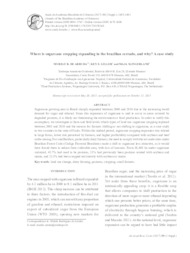Where is sugarcane cropping expanding in the Brazilian cerrado, and why? A case study.
Where is sugarcane cropping expanding in the Brazilian cerrado, and why? A case study.
Autoria: ARRUDA, M. R. de; GILLER, K. E.; SLINGERLAND, M.
Resumo: Sugarcane growing area in Brazil sharply expanded between 2000 and 2010 due to the increasing world demand for sugar and ethanol. Since this expansion of sugarcane is said to occur in areas covered by degraded pastures, it is likely not threatening the environment or food production. In order to verify this assumption, we investigate at farm and field levels which types of land use sugarcane cropping replaced between 2005 and 2010 and the reasons for farmers shifting or not shifting to sugarcane, as a case study in two counties in the state of Goiás. Within the studied period, sugarcane cropping expansion was related to large farms, lower risk perceived by farmers, and higher profitability compared with soybean and beef cattle-raising. For smallholders, particularly dairy farmers, the need to comply with the set-aside rules under Brazilian Forest Code (Código Florestal Brasileiro) made a shift to sugarcane less attractive, as it would have forced them to reduce farm cultivable area, with loss of incomes. From 30,408 ha under sugarcane surveyed, 45.7% had used to be pastures, 31% had previously been pastures rotated with soybean and maize, and 23.3% had been cropped exclusively with soybean or maize.
Ano de publicação: 2017
Tipo de publicação: Artigo de periódico
Unidade: Embrapa Amazônia Ocidental
Palavras-chave: Cana-de-açúcar, Cropping, Small farmers
Observações
1 - Por padrão são exibidas publicações dos últimos 20 anos. Para encontrar publicações mais antigas, configure o filtro ano de publicação, colocando o ano a partir do qual você deseja encontrar publicações. O filtro está na coluna da esquerda na busca acima.
2 - Para ler algumas publicações da Embrapa (apenas as que estão em formato ePub), é necessário ter, no celular ou computador, um desses softwares gratuitos. Sistemas Android: Google Play Livros; IOS: iBooks; Windows e Linux: software Calibre.
Acesse outras publicações
Acesse a Base de Dados da Pesquisa Agropecuária (BDPA) para consultar o acervo completo das bibliotecas da Embrapa.

